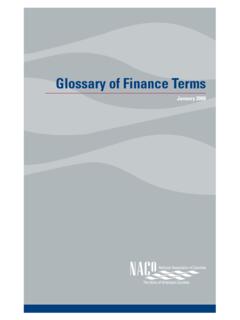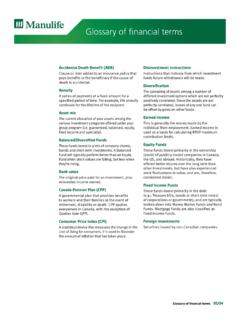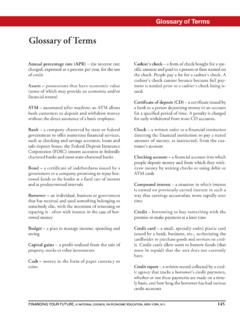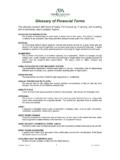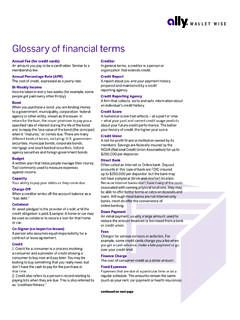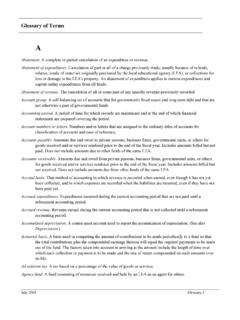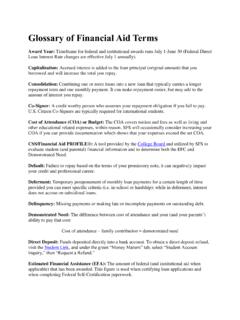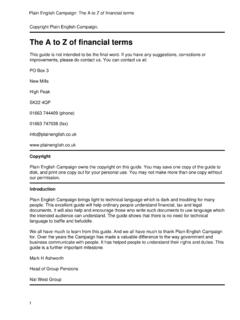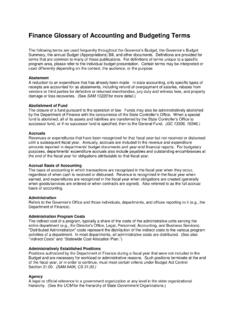Transcription of Glossary of Rule #1 Financial Terms
1 1 Glossary of Rule #1 Terms #10-10 rule A concept used when determining whether a busi-ness has Meaning (one of the Four Ms) to you as a Rule #1 investor. The rule states that you should not Own a business for 10 seconds if you are not willing to own it for 10 years. A Analyst consensus growth rateA forecasted earnings growth rate that is de rived from the forecasts of all the professional analysts following a particular companyAsset Resources controlled by a company from which future economic benefits are expected to be gen-erated. In a business, an asset is something the business owns that has a dollar value. (An asset in general is anything of value that can be traded.) An intangible asset is an asset that has a dollar value but may not be worth anything unless the business is successful. Typically this is an asset that was acquired through buying another business. The price paid in excess of that business s net worth is often called goodwill and is treated as an asset for GAAP Audacious Goal -- Coined by author Jim Collins in the book Good to Great, Rule #1 investors seek businesses led by CEOs driven by BAGs.
2 These goals are bigger and more meaningful than mere mission statements in that BAGs are about passion and relentless drive to change the world in some small or big sheetThe Financial statement that presents a company s current Financial position by disclosing the assets, liabilities and equity claims as of a particular point in EPSNet earnings that are available to common share-holders. This is calculated as net income minus pre-ferred dividends, divided by the weighted average number of common shares investor who acts on the belief that a security or the market is falling or is expected to standardized measure of of Rule #1 Financial Terms2 Glossary of Rule #1 TermsBig FiveThe five Financial calculations help to confirm the existence of a Moat (see definition) in a business, which translates to the business being protected from competition and thereby having a predictable future.
3 Rule #1 investors only invest in businesses if all five of the Big Five numbers are equal to or greater than 10 percent per year for the last 10 years. The Big Five numbers are:1. Return on Investment Capital (ROIC)2. Sales growth rate3. Earnings per Share (EPS) growth rate4. Equity, or Book Value per Share (BVPS), growth rate5. Free Cash Flow (FCF or Cash) growth rateBondA debt investment, as in your loaning money to the government, which borrows from you for a defined period of time at a specified interest rate. The government issues you a certificate, or bond, that states the interest rate (coupon rate) that will be paid and when the loaned funds are to be returned (maturity date). These are often called T-bonds or T-bills, short for treasury bonds or ValueThe net asset value of a company, calculated by total assets minus intangible assets (patents, goodwill) and liabilities.
4 It s what the business is worth if you shut it value Equity Per Share The amount of book value of common equity per share of common stock. This is calculated as book value of shareholders equity divided by the number of common shares investor who thinks the market or a specific secu-rity or industry will rise. A bull market is an extended period in which the market consistently optionA contract that gives the holder the right to buy an underlying asset from another party at a fixed price over a specified period of timeCapital Gains TaxA tax on the increase in the value of an asset; the difference in what you paid to purchase that asset and what you sell it for. (The gain is not realized until the asset is sold.) A capital gain may be short-term (one year or less) or long-term (more than one year). Long-term capital gains are usually taxed at a lower rate than regular income.
5 So, if you sell stocks six months after you purchased them and take profits, you ll be taxed at a higher rate than if you sell them one year and one day after you originally bought them (assuming you can still take profits).3 Glossary of Rule #1 TermsCommodity A bulk good that s traded on an exchange or in the cash market. Examples include grain, oats, coffee, fruit, gold, oil, beef, silver, and natural gas. A commodity business, on the other hand, is what we call any company that produces a product that anyone else can similarly produce, thus eliminating a Moat. If you own a strawberry patch, for example, chances are a neighboring strawberry patch can easily compete with you. A strawberry from your patch is not going to be all that different from a strawberry from your neighbor. It s very difficult and expensive to create a Moat and protect it with a commodity annual growth rate (CAGR)The year-over-year growth rate of an investment over a specified period of time.
6 It s an imaginary number that describes the rate at which an invest-ment would have grown if it grew at a steady Score (0-100)A measure of how constant a company s growth has been. Companies with high consistency scores are ones that have expand ed their operations and value without demonstrating a significant amount of variability in their growth callAn option strategy where the holder of an asset sells a call op tion on a previously purchased stock. The two potential scenarios at option expiration are to create cash flow equal to the option premium received or to effectively sell the stock at a price equal to the stated strike price plus the premium received. This is an alternative way to sell stocks especially when the stock is not currently trading in the red spreadA limited risk option strategy that is implemented by selling one naked option, which incurs an obligation to perform and offsetting that obli gation by buying a second option at a different strike price that gives you the right to make someone else liabilitiesShort-term obligations that are expected to be settled in the ratioLiquidity ratio calculated as current assets divided by current li of Rule #1 TermsDDebt-to-equity ratioSolvency ratio calculated as total debt divided by total debt plus total shareholders to-earnings ratioThe amount of years it would take a company to pay off its debt using its current annual Score (0-100)
7 Companies with high scores are ones that have very little debt or that can pay off their current debt load using their earnings in a rela tively short period of time. Scores of 100 indicate no current debt load, while lower scores indicate increasingly higher levels of debt in relation to systematic allocation of costs of long-lived assets to the pe riod during which the assets are expected to generate economic EPSThe EPS (Earnings Per Share) that would result if all dilutive securities were converted into common distribution of cash, stock, or property by a company, based on its earnings, to its shareholders. Dividends are usually quoted per share. They are typically the thank-you notes for owning stocks in a stable company (which usually doesn t have stock prices that move rapidly).Dividends per shareThe dollar amount of cash dividends paid during a period per share of common Cost Averaging (DCA)The practice of buying a certain number of shares in a given stock periodically, so you buy a certain dollar amount of shares regardless of the price per share.
8 This allegedly helps reduce their risk of investing a large amount in a single stock at the wrong time. You buy more shares when the prices are low, and fewer shares when the prices are high. In long side-ways markets, DCA will not reduce the risk of a zero rate of return. For Rule #1 investors, however, you already know what price you are willing to pay, so DCA isn t necessary. Dow Jones Industrial Average. A price-weighted average of 30 significant stocks traded on the NYSE and the Nasdaq. Examples of DJIA companies include General Electric, Disney, McDonald s, and Coca-Cola. Invented by Charles Dow in of Rule #1 TermsEEarnings growth rate (EGR) The compounded growth rate that is used to fore-cast potential future earnings per share. This is used in connection with other valuation assumptions to forecast the future value of the firm and calculate sticker per share (EPS)The amount of income earned during a period per share of common surprise A company announcement of earnings that differs from analysts YieldThe income return that a full owner would receive from the earnings of the company if the company was purchased at the current market price.
9 It is determined by dividing the current earnings per share by the current market (1) Stock or any other security representing owner-ship ( equities are stocks). (2) On the balance sheet, equity refers to the amount of the funds contributed by the owners (the stockholders) plus the retained earnings (or losses). Thus, equity is essentially ownership in an asset after all debts associated with that asset are paid off. The importance of equity to a Rule #1 investor is in its growth rate. The growth rate of equity represents the growing surpluses, which in turn increase the value of the market where securities, commodities, options, or futures are traded. Examples of exchanges include the NYSE, Nasdaq, and of Rule #1 TermsFFour Growth RatesA subset of the Big Five that includes:1. Sales growth rate2. Earnings per Share (EPS) growth rate3. Equity, or Book Value per Share (BVPS), growth rate4.
10 Free Cash Flow (FCF or Cash) growth rateFour MsMeaning, Moat, Management, and Margin of cash flowThe actual cash that would be available to the com-pany s investors after operational how sensitive an option s delta is to a change in the un derlying Zone Delineates the beginning of the potential purchase zone. When ever a particular stock trades below the green zone price then it may be con sidered for purchase. The green zone price can be either the Margin of Safety Price, The Payback Time Price, the lesser of these two prices or for more experi enced investors, 80% of sticker profit marginThis is calculated as gross profit divided by of Rule #1 TermsIIndexAn imaginary portfolio of securities (stocks and bonds) representing a particular market or a portion of it. The S&P 500 is one of the world s best-known indexes, and is the most commonly used benchmark for the stock market.
